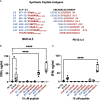Insulin B-chain hybrid peptides are agonists for T cells reactive to insulin B:9-23 in autoimmune diabetes
- PMID: 36032090
- PMCID: PMC9399855
- DOI: 10.3389/fimmu.2022.926650
Insulin B-chain hybrid peptides are agonists for T cells reactive to insulin B:9-23 in autoimmune diabetes
Abstract
Insulin is considered to be a key antigenic target of T cells in Type 1 Diabetes (T1D) and autoimmune diabetes in the NOD mouse with particular focus on the B-chain amino acid sequence B:9-23 as the primary epitope. Our lab previously discovered that hybrid insulin peptides (HIPs), comprised of insulin C-peptide fragments fused to other β-cell granule peptides, are ligands for several pathogenic CD4 T cell clones derived from NOD mice and for autoreactive CD4 T cells from T1D patients. A subset of CD4 T cell clones from our panel react to insulin and B:9-23 but only at high concentrations of antigen. We hypothesized that HIPs might also be formed from insulin B-chain sequences covalently bound to other endogenously cleaved ß-cell proteins. We report here on the identification of a B-chain HIP, termed the 6.3HIP, containing a fragment of B:9-23 joined to an endogenously processed peptide of ProSAAS, as a strong neo-epitope for the insulin-reactive CD4 T cell clone BDC-6.3. Using an I-Ag7 tetramer loaded with the 6.3HIP, we demonstrate that T cells reactive to this B-chain HIP can be readily detected in NOD mouse islet infiltrates. This work suggests that some portion of autoreactive T cells stimulated by insulin B:9-23 may be responding to B-chain HIPs as peptide ligands.
Keywords: B:9-23; HIPS; NOD mouse; T cell; autoimmune diabetes; insulin; type 1 diabetes.
Copyright © 2022 Wenzlau, DiLisio, Barbour, Dang, Hohenstein, Nakayama, Delong, Baker and Haskins.
Conflict of interest statement
The authors declare that the research was conducted in the absence of any commercial or financial relationships that could be construed as a potential conflict of interest.
Figures






Similar articles
-
Mapping of a hybrid insulin peptide in the inflamed islet β-cells from NOD mice.Front Immunol. 2024 Feb 22;15:1348131. doi: 10.3389/fimmu.2024.1348131. eCollection 2024. Front Immunol. 2024. PMID: 38455055 Free PMC article.
-
An insulin-IAPP hybrid peptide is an endogenous antigen for CD4 T cells in the non-obese diabetic mouse.J Autoimmun. 2017 Mar;78:11-18. doi: 10.1016/j.jaut.2016.10.007. Epub 2016 Oct 29. J Autoimmun. 2017. PMID: 27802879 Free PMC article.
-
Characterization of Human CD4 T Cells Specific for a C-Peptide/C-Peptide Hybrid Insulin Peptide.Front Immunol. 2021 May 25;12:668680. doi: 10.3389/fimmu.2021.668680. eCollection 2021. Front Immunol. 2021. PMID: 34113344 Free PMC article.
-
Hybrid insulin peptides are neo-epitopes for CD4 T cells in autoimmune diabetes.Curr Opin Endocrinol Diabetes Obes. 2019 Aug;26(4):195-200. doi: 10.1097/MED.0000000000000490. Curr Opin Endocrinol Diabetes Obes. 2019. PMID: 31166225 Free PMC article. Review.
-
Identifying New Hybrid Insulin Peptides (HIPs) in Type 1 Diabetes.Front Immunol. 2021 Apr 30;12:667870. doi: 10.3389/fimmu.2021.667870. eCollection 2021. Front Immunol. 2021. PMID: 33995402 Free PMC article. Review.
Cited by
-
De novo identification of CD4+ T cell epitopes.Nat Methods. 2024 May;21(5):846-856. doi: 10.1038/s41592-024-02255-0. Epub 2024 Apr 24. Nat Methods. 2024. PMID: 38658646 Free PMC article.
-
Lymphedema pathogenesis involves antigen-driven expansion of CD4+ T cells in skin.Front Immunol. 2025 Aug 1;16:1620571. doi: 10.3389/fimmu.2025.1620571. eCollection 2025. Front Immunol. 2025. PMID: 40821816 Free PMC article.
-
Fifty years of HLA-associated type 1 diabetes risk: history, current knowledge, and future directions.Front Immunol. 2024 Sep 12;15:1457213. doi: 10.3389/fimmu.2024.1457213. eCollection 2024. Front Immunol. 2024. PMID: 39328411 Free PMC article. Review.
-
Exploring new frontiers in type 1 diabetes through advanced mass-spectrometry-based molecular measurements.Trends Mol Med. 2024 Dec;30(12):1137-1151. doi: 10.1016/j.molmed.2024.07.009. Epub 2024 Aug 15. Trends Mol Med. 2024. PMID: 39152082 Review.
-
Proinsulin C-peptide is a major source of HLA-DQ8 restricted hybrid insulin peptides recognized by human islet-infiltrating CD4+ T cells.PNAS Nexus. 2024 Nov 1;3(11):pgae491. doi: 10.1093/pnasnexus/pgae491. eCollection 2024 Nov. PNAS Nexus. 2024. PMID: 39554513 Free PMC article.
References
Publication types
MeSH terms
Substances
Associated data
Grants and funding
LinkOut - more resources
Full Text Sources
Other Literature Sources
Medical
Research Materials
Miscellaneous

